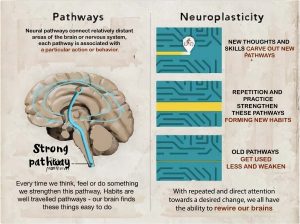Neuroplasticity, also known as brain plasticity and neural plasticity, is the ability of the brain to change throughout an individual’s life. For example, brain activity associated with a given function can be transferred to a different location. The proportion of grey matter can change, and synapses may strengthen or weaken over time. (Wikipedia)
I came to know what I know about stroke is when I had both of my parents suffered from it years ago in different times.
They luckily manage to recovered fully due to the speed of handling. The paramedics came during the golden-period of stroke and my father was soon taken into treatment. The golden period of stroke is between 4 to 6,5 hours. The treatment usually consist of fluid and medications given intravenously. Different from an ischemic stroke, a hemorrhage vessel stroke is much more complitated and took surgery to remove the blood clot that’s pressuring the brain nerves.
How it works
The brain as you see is consist of two hemispheres, right and left, the two cerebral cords are completely divided. Your right hemisphere is responsible for short-term memory, which is the present. They live in the now. They are the screen that showing pictures inside your head, and the part that does the movement learning of your entire body kinesthetic.
On the other part, your left hemisphere works miraculously to develop the long-term structure of memory. It plays the role of collecting the past experience and reorganizing what the future might install for us. They possessed the analytical skills and brings out the most often. It also emphasise your habitual pattern and the fight or flight system.
The longer your nerves “collapsed” in a certain period of time and no recuperation are being made, the impairment is also greater.
They need to be awaken immediately with a number of sensory activities. These activities conducted by your right hemisphere repetitively creating new neurons. Neurons are essential in order to strengthen the rewiring process, recorded by your left cerebral. This is the path to brain plasticity.
Here’s how it really goes :
Neurons carry information in the form of an electrical impulse called an action potential that is initiated at the cell body and it travels. At the synapse, there is a conversion of electrical impulse into a chemical signal. Neurotransmitters diffuse across the synaptic cleft, where they bind to receptors and generate an electrical signal in the postsynaptic neuron. The post-synaptic cell will then, in turn, fire an action potential if the sum of all its synapses reaches an electrical threshold for firing.

Source : Pinterest, Copyright of Alta Mira , California, 2015.
Since a neuron receive synapses from many different presynaptic cells, each cell is able to integrate information. The information came from varied sources. The information will eventually be in the form of an electrical code. The ability of neurons to modify the strength of existing synapses, as well as form new synaptic connections, called neuroplasticity.
Practice Makes Perfect
So, enough for the clinical mumbling, in general, what triggers that ability to modify the power of these neuron synapses?
An Individual behavior in learning new skills along their lifespan placed a huge part in determining the change of their brain. As you grew resilient in exercising the techniques, the forming of new neurons are stronger.
Reinforcement involves a great deal of neurons creation in brain rewiring.
In stroke patients, the rate of recovery to a normal life is particularly high and faster for those who are frequently juggling between therapy and other neurons stimulations. Research and studies 2018 have shown that a quarter of stroke survivors in England, Wales, and Northern Ireland are able to live alone.
More information available here : (https://www.stroke.org.uk/system/files/sotn_2018.pdf )
The more you engaged in neuroplasticity activity, the bigger chance of new neural connections are moulded in your brain.
Solve a logical puzzle, reward yourself, learn a new instrument, make yourself proud with the progress, master a new gadget or simply indulge your senses of a new atmosphere to induce the dopamine naturally.
Start from now, thank me later 😉
Author: Fraya
A writer and entrepreneur with profound interest in humankind research and insights. An avid coffee drinker and book hoarder. Hours and days spent in Jakarta.
The Haptic Room is supported by our readers. Our site may contain links to affiliate websites, and if you make a purchase through these links, we receive a commission to support our site.

